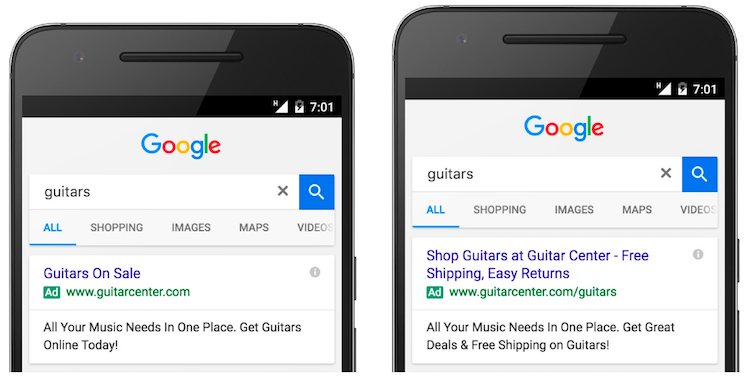Expanded Text Ads – Google Text Ads PPC
Understanding Google Text Ads

Enhance PPC Performance with Google Text Ads
In today’s digital era, advertising has evolved significantly. Gone are the days of relying solely on print media or billboards to get your message across. With the advent of the internet, a new era of advertising has emerged – digital advertising. And at the heart of digital advertising lies text ads, a powerful tool that can help businesses reach their target audience effectively.
What Are Text Ads?
Text ads, as the name suggests, are advertisements consisting primarily of text. They are typically displayed on search engine results pages (SERPs), websites, or within mobile apps. Unlike display ads, which incorporate images or videos, text ads rely solely on the power of words to capture attention and drive conversions.
Crafting Compelling Text Ads
Writing effective text ads requires a combination of creativity, strategic thinking, and an understanding of your target audience. Here are some key tips to help you create compelling text ads that captivate and convert:
- Understand Your Audience: Before you start writing your text ad, take the time to understand your target audience. What are their pain points? What solutions are they seeking? By identifying their needs, you can tailor your ad copy to resonate with them.
- Keywords Are Key: Incorporate relevant keywords into your ad copy. Keywords are the search terms that people use when looking for products or services. Including these keywords in your ad helps search engines identify its relevance and display it to the right audience.
- Grab Attention with a Headline: The headline is the first thing users see when your ad appears. Make it compelling and attention-grabbing. Use action-oriented language, convey a clear benefit, and make it irresistible to click.
- Focus on Benefits: Highlight the unique selling points and benefits of your product or service in the ad body. Explain how your offering can solve the user’s problem or enhance their life. Use persuasive language and appeal to emotions.
- Call to Action: Every effective text ad needs a strong call to action (CTA). A CTA prompts users to take the desired action, such as “Buy Now,” “Learn More,” or “Sign Up Today.” Make your CTA clear, concise, and compelling.
Crafting Effective Expanded Text Ads

Google Text Ads PPC for enhanced digital advertising performance
Understanding the Power of Text Ads
Text ads are concise yet impactful advertisements that primarily consist of text. They are commonly displayed on search engine results pages (SERPs), websites, or within mobile apps. Unlike visual ads that rely on images or videos, text ads leverage the power of words to convey messages, engage users, and entice them to take action.
Unleashing the Potential of Your Text Ads
To create text ads that truly resonate with your target audience and yield exceptional results, consider the following strategies:
- Research and Identify High-Volume Keywords: Begin by conducting thorough keyword research to identify popular and relevant terms that align with your business and target audience. These high-volume keywords will enable your text ads to appear when users search for related products or services, increasing the chances of attracting qualified leads.
- Compelling Headlines That Demand Attention: Craft captivating headlines that immediately grab the reader’s attention. Use action-oriented language, pose intriguing questions, or offer enticing solutions to pique curiosity. A well-crafted headline is the gateway to capturing your audience’s interest and encouraging them to read further.
- Emphasize Unique Selling Propositions: Highlight the unique features, benefits, or advantages of your products or services in a clear and concise manner. Use persuasive language that appeals to your audience’s needs and aspirations. By clearly communicating the value your offering provides, you can differentiate yourself from competitors and inspire action.
- Create Engaging and Persuasive Ad Copy: Focus on creating ad copy that engages readers and persuades them to take the desired action. Showcase how your product or service addresses the pain points of your target audience and enhances their lives. Use emotional appeals, storytelling techniques, and testimonials to establish trust and credibility.
- Call to Action That Drives Conversions: A strong and compelling call to action (CTA) is essential for driving conversions. Clearly and concisely instruct your audience on the next steps they should take, such as “Shop Now,” “Sign Up Today,” or “Request a Free Consultation.” Make your CTA stand out visually and position it strategically within your text ad.
Best Practices for Text Ads

Optimizing ad performance with compelling copywriting strategies
In the world of PPC, Expanded Text Ads are the key to unlocking a new dimension of advertising excellence on Google.
Understanding the Impact of Text Ads
Text ads are concise, yet impactful advertisements that rely solely on written content. They are prominently displayed on search engine results pages (SERPs), websites, and mobile apps. Through carefully crafted copy and strategic placement, text ads can effectively engage users and entice them to take action.
Unleashing the Power of Persuasive Copy
To create text ads that captivate your audience and maximize your advertising success, follow these best practices:
- Research High-Volume Keywords: Begin by conducting thorough keyword research to identify relevant and high-volume search terms. Incorporate these keywords naturally into your ad copy to ensure that your text ads are displayed to the right audience at the right time.
- Compelling Headlines: Grab your audience’s attention with bold and compelling headlines. Use powerful words, pose thought-provoking questions, or create a sense of urgency to pique curiosity. A captivating headline is your first opportunity to make a lasting impression and entice users to continue reading.
- Focus on Benefits: Highlight the unique selling points and benefits of your product or service. Clearly articulate how your offering solves a problem, saves time, or enhances the lives of your potential customers. Use persuasive language and vivid imagery to make your text ads memorable and impactful.
- Concise and Persuasive Ad Copy: Keep your ad copy concise while conveying a persuasive message. Clearly communicate the value proposition of your product or service in a compelling manner. Use language that evokes emotion, storytelling techniques, and social proof to build trust and credibility with your audience.
- Clear Call to Action (CTA): End your text ads with a clear and compelling call to action. Encourage users to take the desired action, such as “Shop Now,” “Sign Up Today,” or “Request a Free Trial.” Make your CTA stand out visually and position it strategically within your text ad to drive conversions.
Ad Platforms for Text Ads

Optimizing ad performance on Google through strategic PPC campaigns
Understanding the Power of Ad Platforms
Ad platforms are online channels or networks that provide businesses with the tools and infrastructure to create, manage, and optimize their advertising campaigns. These platforms offer access to a vast audience base, targeting options, and analytics to measure the effectiveness of your text ads. Choosing the right ad platform is crucial to reaching your ideal customers and maximizing your return on investment.
Exploring the Best Ad Platforms for Text Ads
When it comes to text ads, several ad platforms stand out for their features, reach, and targeting capabilities. Here are some of the top platforms that I have personally found effective:
- Google Ads: Google Ads is the industry leader in online advertising, offering a robust platform for creating and managing text ads. With its expansive reach and powerful targeting options, Google Ads campaigns allow you to display your text ads on search engine results pages, websites, mobile apps, and more. The platform provides valuable insights and optimization tools to maximize the performance of your campaigns.
- Microsoft Advertising: Formerly known as Bing Ads, Microsoft Advertising is another major player in the digital advertising space. With a significant market share, Microsoft Advertising enables you to reach millions of potential customers through text ads displayed on Bing search results, Yahoo, and partner websites. Its unique audience demographics and integration with other Microsoft services make it a compelling platform to consider.
- Facebook Ads: Facebook Ads offers an extensive reach, allowing you to target specific audiences based on demographics, interests, and behaviors. While Facebook is primarily known for its visual ads, the platform also supports text ads that can appear in users’ news feeds or on the right-hand column. With advanced targeting options and robust analytics, Facebook Ads empowers businesses to create highly targeted and engaging text ad campaigns.
- LinkedIn Ads: For businesses targeting professionals and B2B audiences, LinkedIn Ads is an excellent platform to consider. LinkedIn offers text ads that can be displayed in users’ news feeds, inboxes, or on the LinkedIn Audience Network. With its precise targeting options based on job titles, industries, and company size, LinkedIn Ads enables you to reach decision-makers and influencers in your desired niche.
Comparison of Various Types of Text Ads Across Different Platforms
| Feature | Google Expanded Text Ads | Google Standard Text Ads | Bing Text Ads | Facebook Text Ads |
|---|---|---|---|---|
| Headlines | Three (30 characters each). | Two (25 characters each). | Two (30 characters each). | One (25 characters). |
| Descriptions | Two (90 characters each). | One (80 characters). | Two (80 characters each). | One (125 characters). |
| Display URL | Two “Path” fields. | No “Path” fields. | Customizable URL. | URL visible in the post. |
| Total Characters | Up to 300 characters. | Up to 140 characters. | Up to 250 characters. | Varies by ad placement. |
| Ad Format | Extended text information. | Concise format. | Similar to Google Standard. | More visual-focused with text. |
| Visibility | Prominent on search page. | Less prominent. | Dependent on keywords. | In the Facebook feed. |
| Customization | High flexibility. | Limited space. | Moderate customization. | Visual + text customization. |
| Ease of Implementation | More content to create. | Quicker to create. | Similar to Google Standard. | Requires visual elements. |
| Targeting Options | Keywords, audience, etc. | Keywords, audience, etc. | Keywords, demographics, etc. | Demographics, interests, etc. |
| Platform Integration | Integrated with Google Ads. | Integrated with Google Ads. | Integrated with Microsoft Ads. | Integrated with Facebook Ads. |
| Suitable for | Detailed products/services. | Short, concise messages. | Similar to Google Standard. | Visual storytelling with text. |
Tracking and Analytics
Understanding the Impact of Tracking and Analytics
Tracking and analytics involve the collection, measurement, and interpretation of data to gain a comprehensive understanding of your digital strategy’s performance. It allows you to monitor key metrics, identify trends, and make informed decisions to optimize your marketing efforts. By implementing effective tracking and analytics practices, you can uncover valuable insights that drive the success of your campaigns and overall business growth.
Unleashing the Power of Data-Driven Decision-Making
To harness the potential of tracking and analytics, consider the following best practices:
- Defining Goals and KPIs: Start by clearly defining your business goals and key performance indicators (KPIs). Determine the metrics that align with your objectives, such as conversion rate, click-through rate, bounce rate, or customer lifetime value. This will provide a framework for tracking and measuring the success of your digital marketing activities.
- Implementing Tracking Codes: Incorporate tracking codes, such as the Google Analytics tracking code, into your website or landing pages. These codes allow you to collect valuable data about user interactions, traffic sources, and conversion events. Ensure that tracking codes are correctly implemented across all relevant pages to capture accurate and comprehensive data.
- Analyzing Data: Regularly review and analyze the data collected from tracking codes. Utilize analytics tools to gain insights into user behavior, demographic information, device preferences, and more. Identify patterns, trends, and areas of improvement to optimize your marketing campaigns and enhance the user experience.
- Testing and Optimization: Implement A/B testing to experiment with different elements of your digital strategy, such as ad copy, landing page design, or call-to-action buttons. Use analytics data to measure the performance of each variation and identify the most effective elements. Continuously refine and optimize your campaigns based on data-driven insights.
- Monitoring Campaign Performance: Keep a close eye on the performance of your digital campaigns in real-time. Monitor metrics such as impressions, clicks, conversions, and ROI to gauge the success of your efforts. Use tracking and analytics data to identify underperforming areas and make data-driven adjustments to improve outcomes.
FAQ: Responsive Search Ads PPC
What are ad extensions and how do they enhance your Google Ads?
Ad extensions are additional pieces of information that expand your ad and provide more value to potential customers, increasing visibility and CTR.
How does the display URL work in Google Ads?
The display URL is the visible web address shown in your ad and helps users understand where they’ll land if they click on your ad.
What is the role of an advertiser in Google Ads?
An advertiser is someone who uses Google Ads to create and manage advertising campaigns for their products or services.
How can you make your ad stand out and be more effective?
To make your ad more effective, ensure it has compelling ad copy, relevant keywords, and appealing ad extensions.
What is CTR, and why is it important in Google Ads?
CTR (Click-Through Rate) is the percentage of users who click on your ad after seeing it. It’s a key metric that measures ad performance and relevance.
What is an ad group in Google Ads, and how does it contribute to campaign organization?
An ad group is a collection of related keywords and ads. It helps organize your campaign, ensuring that ads are relevant to specific keyword themes.
How does Google’s Quality Score affect your ads’ performance?
Google’s Quality Score is a rating that influences your ad position and cost per click. Higher Quality Scores result in better ad placement and lower costs.
Why is it a good idea to advertise on Google’s search network?
Advertising on Google’s search network allows your ads to appear on the search results page when users enter relevant queries, reaching potential customers actively looking for products or services.
What ad format is commonly used for text ads on Google Ads?
Text ads are a popular ad format on Google Ads, consisting of an ad headline, description lines, and a display URL.
How can you use ad customizers to create dynamic and personalized ads?
Ad customizers enable you to dynamically insert specific information into your ads, such as prices, countdowns, or location details, making your ads more relevant and engaging to users.
Is it a good idea to use CTAs (Call-to-Actions) in your Google Ads to encourage users to take specific actions?
Yes, using CTAs in your ads can be effective in prompting users to click on your ad and engage with your website or landing page.
What should you consider when writing the ad description for your Google Ads?
When writing the ad description, you should focus on conveying a clear and compelling message about your product or service within the character limit.
How many characters are allowed in Google Ads headlines?
Google Ads allows two headlines, each with a character limit of 30 characters, providing more space to capture users’ attention.
Where do text ads often appear on Google Search results?
Text ads can appear at the top and bottom of Google search results when they are relevant to the user’s search query.
Can you use location extensions in your Google Ads?
Yes, you can use location extensions to display your business address alongside your ads, making it easier for local customers to find you.
What are the best-performing ad formats for Google Ads?
Text ads are one of the best-performing ad formats on Google Ads, offering simplicity and relevance to users.
How many headlines can you include in a Google Ads text ad?
You can include two headlines in a Google Ads text ad, each with a character limit of 30 characters.
Does Google allow you to create three headlines in a text ad?
No, Google Ads allows only two headlines, not three, in a text ad.
Are ad extensions available for mobile devices in Google Ads?
Yes, ad extensions are available for both desktop and mobile devices, enhancing the visibility and performance of your ads.
How can landing page copy help you write effective Google Ads?
The landing page copy should align with your ad’s message and provide relevant information to users, ensuring a seamless user experience and higher conversion rates.
© PhoenixProject, with full or partial copying of the material, a link to the source is required.

Comments: 0